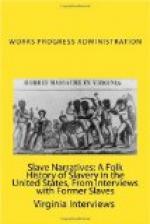Aunt Harriet lived at the present behind the White Methodist Church in Lancaster. The daughter with whom she lives is considered one of the high class of colored people in Lancaster. She holds an A.B. Degree, teaching in the colored city school, and is also a music teacher. She stands by the teaching of her mother, being a “Good Methodist”; giving of her time, talent, and service for her church.
Bibliography:
Interview with Aunt Harriet Mason, Lancaster, Kentucky.
Garrard County. Ex-Slave Stories. (Eliza Ison)
Interview with Bert Mayfield:
Bert Mayfield was born in Garrard County, May 29, 1852, two miles south of Bryantsville on Smith Stone’s place. His father and mother were Ped and Matilda Stone Mayfield, who were slaves of Smith Stone who came from Virginia. His brothers were John, Harrison, Jerry, and Laurence, who died at an early age.
He lived on a large plantation with a large old farm house, built of logs and weatherboards, painted white. There were four rooms on the first floor, and there were also finished rooms on the second floor. An attic contained most of the clothes needed for the slaves. “Uncle Bert” in his own language says, “On Christmas each of us stood in line to get our clothes; we were measured with a string which was made by a cobbler. The material had been woben by the slaves in a plantation shop. The flax and hemp were raised on the plantation. The younger slaves had to “swingle it” with a wooden instrument, somewhat like a sword, about two feet long, and called a swingler. The hemp was hackled by the older slaves. The hackle was an instrument made of iron teeth, about four inches long, one-half inch apart and set in a wooden plank one and one-half feet long, which was set on a heavy bench. The hemp stalks were laid on these benches and hackled herds were then pulled through and heaped in piles and taken to the work shops where it was twisted and tied then woven, according to the needs. Ropes, carpets, and clothing were made from this fiber.
“Our cabins were usually one room with a loft above which we reached by a ladder. Our beds were trundle beds with wheels on them to push them under the big beds. We slept on straw ticks covered with Lindsey quilts, which were made from the cast-off clothes, cut into squares and strips.”




